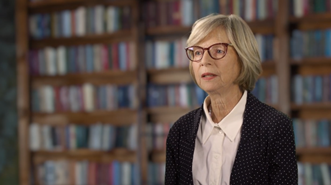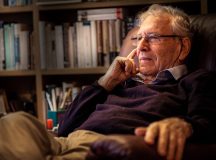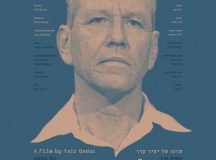Liam Hoare talks to literary scholar Nurith Gertz about What Was Lost to Time (Hebrew), her biography of the novelist Amos Oz, as well as a psychological examination, a literary study, and a memoir of a friendship that went back to the early 1970s.
In 2015, Amos Oz was first diagnosed with cancer. ‘He was sick, and he knew his time was very short’, the literary scholar Nurith Gertz tells me during a phone conversation from her home near Jerusalem. Having spoken on the phone at the same time every Sunday for decades, Oz and Gertz veered from their regular schedule and began to talk almost daily. In those years before his death Oz had a request of Gertz. Write about me, he said, and don’t just write about my qualities or the things I have already covered in A Tale of Love and Darkness (2002), his novel-cum-memoir about his family history and the birth of Israel. As Gertz recounts in her 2020 book What Was Lost to Time, Oz told her:
Write things like, ‘He was a spoiled person.’ Write, ‘He was a person who sought respect.’ Write, ‘He was a person in love with the sound of his own voice.’ … Write that this person is a walking masquerade ball. That he’s trying so hard to please everybody, trying so hard to please even people who don’t deserve to be pleased. Write everything. Don’t write me an ode, don’t write me a love song, that isn’t what I need. Write whatever you write. … You won’t be writing anything too awful, I don’t think.
Oz died on 28 December 2018; two years later, Gertz would What Was Lost to Time in Hebrew: in turn a biography, a psychological examination, a literary study, and a memoir of a friendship that went back to the early 1970s, when Gertz first came under the spell of Oz’s work. (A commendable English translation has been completed by Yardenne Greenspan, though it has yet to find a publisher.) Gertz says of her book’s origins during our interview that ‘all his life, he was occupied with the question of what would remain of him after his death. He wanted to stay alive, so he wanted someone to write a book about him and he thought I could be the person to write it’.
By this time, Gertz—professor emerita of Hebrew literature and film at Israel’s Open University—and Oz had known one another for over 40 years. They first met in 1973 at Café Peter in Jerusalem, after Gertz had written her Master’s thesis on Oz in Tel Aviv University’s literature department and phoned him asking to meet. Back then, he would tell her—as he told other interviewees over the years—that everything you need to know about me is contained in my novels. He spoke sentences that Gertz already knew, ones that been honed and refined in his writing, each word carefully chosen. ‘He had found the best way to express everything’, Gertz says, ‘so why not repeat it?’
Gertz’s first work on Oz, Amos Oz: Monograph, was published in 1980, and it laid the groundwork for countless other studies of his literature. Their bond was both intellectual and personal. Gertz was married to the writer Amos Kenan (whose works include the dystopian novella The Road to Ein Harod) with whom she had two children. Their families, in a sense, grew up together for a time, visiting one another at Gertz and Kenan’s home in Tel Aviv or Kibbutz Hulda, where Oz, his wife Nily, and his three children Fania, Galia, and Daniel lived until the mid-1980s prior to their move to Arad. Oz told Gertz in one of his late-in-life confessions: ‘I’m so embarrassed and regretful that we didn’t leave the kibbutz…when the girls were little. …Where were my eyes to see how much my children suffered? All I could think about was myself’.
This side of Oz was not always visible to us during his lifetime. Only towards the very end did he begin to speak of his torment, his regrets, and his guilt. Such matters do arise in his conversations with his editor Shira Hadad, published in What Makes an Apple (2018), but his inner turmoil is very much front and centre in the documentary film The Fourth Window—in which Gertz and her phone conversations with Oz play a prominent role—and What Was Lost to Time. He told Gertz:
Tell that ever since this man’s mother left him when he was twelve and a half, he’s spent years feeling, deep inside, that he’s worthless. No matter how much the world spoiled him, how many languages his books had been translated into, how many articles were written about him, and how many copies his books sold. He keeps fighting the feeling that he isn’t worth anything, keeps searching for someone to tell him, ‘You’re worth something. You’re worth something.’ … Nothing can seal that hole. No success, no glory, no awards. You aren’t worth anything as a person, not worth anything as a man, because the woman who was the most important to you in the world slammed the door on you and left.
‘He lived with the feeling of guilt’, Gertz tells me, one that went back to his mother’s suicide that took place when Oz was but 12 years old. Oz felt, in some sense, that his mother’s death was his fault, that for ‘her to leave me forever must mean that there’s something wrong with me’, Gertz hypothesises. When he was younger, these feelings of guilt found expression as anger and aggression, including anger towards his mother for abandoning him. These feelings are perceptible in his earliest novels and short stories such as those collected in Where the Jackals Howl (1965), brooding, larger-than-life stories full of fear, threats, violence, and a deep sense of foreboding about the future of the kibbutz and the nation.
His mother’s suicide ‘left a hole in his life, in his heart,’ Gertz says, and ‘everything he did in his life was partly an attempt to patch that hole, to make right what had happened to him’. But all the adulation he received during the course of his life—the praise, the effusive critical notices, the awards—was in some sense never enough. He was, Gertz believes, always looking for a love to replace the love of his mother. ‘Everyone he talked to, he gave them the feeling that they were special, they were the one, they wouldn’t be deserted—that he wouldn’t leave them like his mother left him’.
‘And that was a problem, because you can’t love everybody. You have to reserve love for those who are special to you, for people who are close to you, and this was a kind of problem’. What Was Lost to Time ends at the conclusion of Oz’s life, and as such does not touch on the allegations raised by his daughter, Galia, of what she characterised as physical and emotional abuse. ‘He talked a lot about Galia. Many of our conversations at the end of his life were about Galia’, Gertz tells me, but in the end, she decided to remove her chapter on Galia from What Was Lost to Time upon the family’s request. ‘I thought not hurting people was much more important than publishing a good book’, she tells me. In our conversation, Gertz stated she did not wish to comment any further on this private family matter.
What Was Lost to Time is a personal document as well as a literary inquiry. Taking his body of work as a whole, Gertz observes a perceptible change in style from his earliest novels including My Michael (1968) and The Hill of Evil Counsel (1976) through to A Tale of Love and Darkness, which Gertz describes as her favourite of his books. It is not only that his anger dissipated and that his prose became quieter, calmer, but that he took on board the criticism that his work was in some sense ‘larger than life, that nothing in his work was really as it truly is, that everything had to be more beautiful somehow,’ Gertz says. In those early stories, ‘he was trying to find something better than real life. He was trying to show us a kind of ideal world, and in his books, people dream of a more complete life, a more perfect life, one in which all their hopes will be fulfilled and there would be no want or suffering’. This metaphorical Jerusalem is one his characters strive for, though are never able to reach.
Beginning with novels like Fima (1991) and Don’t Call It Night (1994), however, Oz ceased trying to reject or rebel against real life and came, in a sense, to accept it as it was, finding a language and style in which to simply describe the world and its ephemera rather than try and perfect it. This acceptance of reality finds its fullest expression in A Tale of Love and Darkness. His mother is, of course, all over his novels: in My Michael and The Hill of Evil Counsel, in Soumchi (1978) and A Panther in the Basement (1995), among many others. But in A Tale of Love and Darkness, ‘he comes closer to the truth of his life, his feelings, his relationships. He doesn’t try, as in other books, to beautify everything’. In A Tale of Love and Darkness, Gertz says, Oz comes as close as he ever got to accurately describing his own life.
Yet his legacy, Gertz concludes, is as a kind of dreamer. Among his generation of writers, ‘he gave perfect expression to an era in which people still adhered to dreams’—not only the Zionist dream of a land in which the Jewish people’s hopes and desires would be materialised, where nationalism, liberalism, and humanism would meld and create a perfect world, but also the dream of a world without pain or suffering or one in which we might form better connections with other people.
Oz was a writer, a reader, and a dreamer. He believed that Israel itself was born out of a dream—or rather, out of several conflicting, contradicting and mutually exclusive dreams, all of which nonetheless shared the notion that the Jewish people had nowhere else to go bar the Land of Israel. ‘Israel is a dream come true and, as such, it is disappointing,’ Oz said in the 2009 documentary Amos Oz: The Nature of Dreams. But ‘the taste of disappointment is not in the nature of Israel, it is in the nature of dreams.’ The generation of writers that followed Oz, Gertz observes, do not dream of a better future or thinks about dreams in the same way as he did. She reflects: ‘Maybe he was the last of his kind’.



































